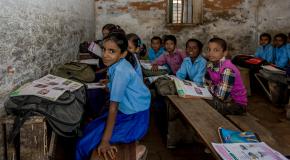Anurag Behar is CEO of Azim Premji Foundation and vice chancellor, Azim Premji University. For this Q&A supported by the International Commission on Financing Global Education Opportunity, the Economist Intelligence Unit (EIU) asked Mr Behar about why education matters. The Commission is delivering a report on the economic imperative of education, entitled “The Learning Generation: Investing in Education for a Changing World”, during the UN General Assembly.
Mr Behar, who is also chief sustainability officer of Wipro, believes strong public education underpins economic growth. For the past 12 years, he has led programmes and collaborated with state policymakers across India to make significant and impactful improvements benefitting students and teachers in more than 350,000 schools. Azim Premji University’s programmes focus on teacher education and development.
EIU: The world’s poorest nations have the most to gain by closing widening skill gaps that threaten the future for tens of millions of school-aged children currently shut out of schools. How can policymakers reverse exclusion so students can attain critical skills needed to lift them out of poverty—and, more broadly, spur national economic growth and stability?
AB: In the late 1980s, enrolment in our schools was 50-55%. Now it is nearly 100%. That’s staggering, achieved by something quite simple: In the early 1990s, the government of India led the policy, which states followed, of making sure there were public schools within 1 kilometre of every habitation.
Today, India has roughly 1.5m schools. This is truly remarkable and has been at the core of how pretty much all children are enrolled in schools across the country. Sending children to school [is now] the norm; that’s been a tremendous social change. [In] the mid-1990s, there were only 70 girls for every 100 boys in primary school. Today, there is parity.
That’s wonderful in terms of inclusion and access, but two big things remain: 1) what we have achieved for children in primary school we have not done in grades nine through twelve. We still have significant dropout rates, especially with girls, after primary school. We need to do something about secondary schools.
The second big issue is the 1%—that’s 2.5m children—still not enrolled. It’s not an issue of schools not being available. It’s a socially determined issue on the part of the family and its socio-economic circumstances. In many cases it’s caused by purely economic circumstances or a migrant population—different causes drive this issue.
EIU: Many outsourcing jobs globally are now at risk because of automation. How can a country keep up with these changes through education to sustain and expand this kind of education-based economic growth?
AB: Less than 10% of the Indian workforce is in the organised sector. In the tech-related sector, it’s perhaps less than 1%. Ninety percent of the workforce is out of the organised sector.
Education must focus on this 90%. To do that, we need to make sure that we invest adequately in the secondary school and higher-education systems. It’s also very important to understand what kind of education we’re talking about: developing basic capacities more than [teaching] any specific skill.
If you change education to [equip students with] specific skills useful in the tech or construction world, for example, you will create a structural problem. The only thing we know about any economy is that in 10, 20, 30 years there will be continue to be rapid change. So the last thing you want to do is educate people with narrowly defined skills. What’s really important is developing fundamental capacities in people like critical thinking, application, analysis, synthesis—so they have the ability to keep learning and re-learning to remain economically productive.
I emphasise this point because the aims of education have always been a battleground. They’re a battleground today, and I’m apprehensive that the approach of focusing on narrow skills will stunt the economic growth of the workforce, and, in any case, the aims of education must not be narrowly economic. They must be broadly social-human.
The Finnish system does a great job of developing these basic capacities. Interestingly, we [in India] have a national curricular framework that is very progressive on this matter. The implementation is poor, but it’s a start. If the curricular approach is good, then you have a chance of making it happen.
EIU: India has some 8m inadequately trained teachers. How to accelerate and improve recruitment and training for teachers and, in turn, shape national education systems for 10, 20 years or even longer?
AB: It’s now clear and widely accepted by policymakers at all levels that the [Indian] teacher-education system is shoddily designed in terms of curriculum, institutions and governing structure. In the last four years, the government has taken a more active and informed role in teacher-education. We have to move to a system that’s five years of good integrated undergraduate work, not two, so teachers develop an understanding of certain subjects and then are trained in education itself. The good news is we have a policy to approach the problem. The tough thing is, given the scale of the country, it will take time, 10 to 15 years.
As important is improving the capacity of teachers currently working. Eight million teachers in the system [still] need help. I see it every day. The large percentage of teachers are committed people who just haven’t gone through the right teacher education so they don’t have adequate capacity to be effective; while some of them develop it through their own hard work, we have a systemic issue.
The government is very conscious of this and there are efforts to address it, but it’s very complex. Eight million people across the country doing full-time jobs and they have to recover years of education.
That’s our primary role at the Foundation. But [we are] unusual in many ways. We are very well-funded. [Wipro founder] Mr Azim Premji has donated 40% of the stock of Wipro for this philanthropic purpose. That gives the Foundation the financial stability to invest deeply in teams of teacher-educators across the country and address teacher education more effectively. But this problem is not resolved overnight. This is multi-generational. It will take 15 to 20 years.




